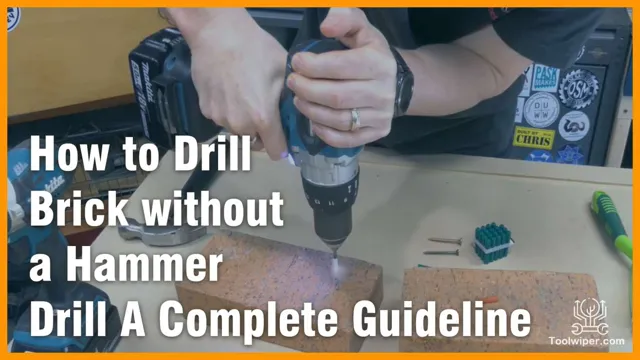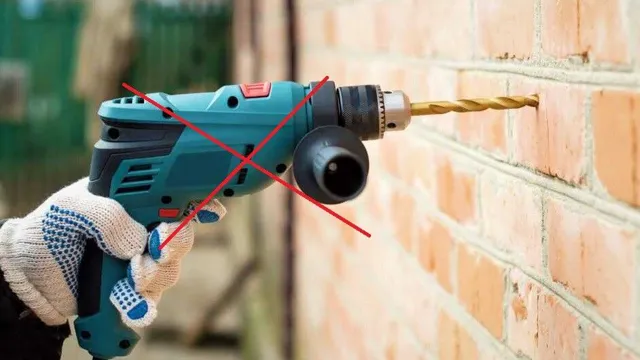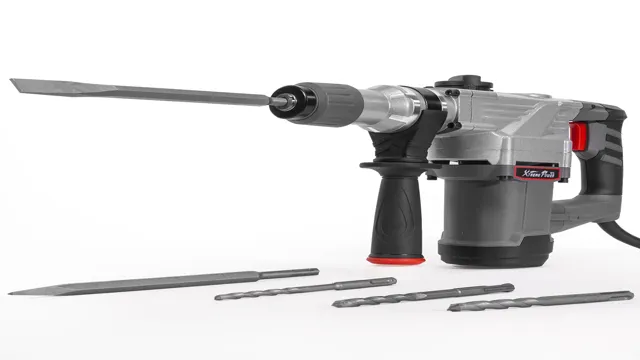How to Drill Through Brick Without a Hammer Drill: Step-by-Step Guide

Drilling through brick can be a daunting task, especially if you don’t have a hammer drill. But don’t worry, because with the right tools and techniques, you can still make a hole through that tough brick wall or surface. In this blog, we’ll show you how to drill through brick without a hammer drill.
Whether you’re a DIY enthusiast or a professional builder, you’ll find these tips helpful in tackling a range of drilling tasks. From choosing the right drill bit to using the correct drilling technique, we’ll cover all the essential steps you need to follow. So let’s get started and learn how to overcome the challenge of drilling through brick without a hammer drill!
Materials Needed
If you’re wondering how to drill through brick without a hammer drill, don’t worry, it’s possible! All you need is a few materials such as a masonry bit, a power drill with high torque, a pair of safety glasses, and a bit of time. First, put on your safety glasses to keep debris out of your eyes. Then, insert the masonry bit into your drill and adjust the speed to high torque.
Hold the drill steady and start drilling into the brick slowly. It’s important to take breaks and let the drill bit cool down as you go, to prevent it from overheating. Keep drilling until you’ve reached your desired depth and dust off any debris that may have accumulated.
With a bit of patience and the right tools, you can easily drill through brick without a hammer drill!
Brick Drill Bit
If you’re planning to do some DIY home improvement projects that involve drilling into brick or concrete, then you’ll need a good brick drill bit. These bits are designed with a harder tungsten carbide material that can easily bore through tough masonry surfaces. But before you start drilling, you’ll need to make sure you have the right tools.
In addition to the brick drill bit itself, you’ll need a power drill with hammer function to create the necessary force. You’ll also need safety goggles and a dust mask to protect your eyes and lungs from the debris that will be generated during the drilling process. Don’t forget to make sure that the bit size matches the fastener you plan to use later on.
With these materials in hand, you can tackle your brick and concrete drilling projects with ease and confidence.

Masonry Bit
When it comes to drilling into hard materials like brick or concrete, a masonry bit is essential. However, it’s important to make sure you have the right materials to successfully accomplish the task at hand. In addition to a masonry bit, you’ll need a power drill, safety glasses, a dust mask, and a measuring tape.
It’s crucial to wear safety glasses to protect your eyes from flying debris. Additionally, wearing a dust mask will prevent you from inhaling hazardous particles while drilling. Measuring tape helps to ensure accuracy in your drilling, as precise measurements are crucial for proper placement of the holes.
With these materials at your disposal, you’ll be able to drill into hard surfaces with ease and efficiency. Remember to follow all safety precautions when using power tools and always keep a steady hand.
Crescent Wrench
When it comes to repairing and fixing things around the house, a crescent wrench is a must-have tool. It’s a versatile tool that allows you to tighten or loosen bolts and nuts of different sizes. But what materials do you need to make a crescent wrench? The answer is relatively simple: the materials vary depending on the type of crescent wrench.
Generally, the main materials used to make crescent wrenches are steel or chrome-plated metal. The handles are usually made of rubber, plastic or composite materials to prevent them from slipping from your hands when you’re using them. Besides the main materials, crescent wrenches may also have additional materials to make them more effective or comfortable to use.
Some may come with cushion grips to reduce hand fatigue, or adjustable jaws to accommodate various sizes of nuts and bolts. As for the size of the wrench, it also depends on the type of job you’ll be doing. Larger crescent wrenches are designed for heavy-duty jobs, while smaller ones are ideal for light work.
In conclusion, crescent wrenches are an indispensable tool for any homeowner or DIY enthusiast. And with the right materials, you can be sure to have a reliable and efficient tool that can handle most of your repair and maintenance tasks with ease. So, next time you need to tighten or loosen a bolt or nut, grab your crescent wrench and get to work!
Cordless Drill
When it comes to using a cordless drill, not only do you need the tool itself, but you also need a few other materials to ensure a smooth and efficient drilling experience. First and foremost, you need drill bits in various sizes to accommodate your specific project’s needs. Depending on the material you are drilling, you may need different types of bits as well, such as spade bits for wood or masonry bits for concrete.
Another essential material is a battery charger to keep your drill’s battery powered and ready to go. Additionally, having a set of screwdriver bits and nut drivers can come in handy for completing your project’s finishing touches. Making sure to have these materials on hand will not only make your job easier, but it can also prolong the life of your cordless drill.
So, before you begin your next project, take inventory of the materials you will need and stock up on any necessary items to ensure a successful outcome.
Technique
If you need to drill through a brick wall but don’t have a hammer drill, don’t worry! You can still get the job done with a few simple tools and techniques. First, you will need a masonry bit, which is designed to drill through tough materials like brick and concrete. You will also need a regular drill, preferably one with a variable speed setting.
To drill into the brick, start by marking the spot where you want to drill. Then, hold your drill perpendicular to the surface of the brick and start drilling at a low speed. Increase the speed gradually as you go, being careful not to apply too much pressure or the bit may get stuck.
Make sure to clean out the hole regularly to remove brick dust and keep the bit from getting clogged. Finally, be patient, as drilling through brick can take longer than other materials. With these tips, you can successfully drill through brick without a hammer drill.
Marking the Spot
“Marking the Spot” is a fundamental technique used by professionals across various industries, including surveying, construction, and geology. It involves accurately placing a marker at a specific location to serve as a guide or reference point for future measurements or analysis. This technique is crucial in ensuring that accurate data is collected and reliable maps or construction plans are created.
At the heart of “Marking the Spot” is the ability to use the right tools to accurately pinpoint a location, which could be as simple as using a tape measure or as complex as using GPS equipment. The process involves a high level of precision, and professionals must pay close attention to detail to avoid miscalculations and errors. By marking a spot accurately, professionals can save time and resources and ensure that future measurements or construction plans are consistent and reliable.
So, if you want to ensure accurate measurements, “Marking the Spot” is a technique that you can’t afford to ignore.
Using the Masonry Bit
If you’re looking to hang something on a masonry wall, you’ll need to use a masonry bit for the best results. But it’s not just a matter of drilling a hole like you would with a regular bit. Using a masonry bit requires a bit of skill and technique.
First, make sure the bit is the correct size for your anchor. Then, use a hammer drill, which makes it easier to drill into masonry. Start by making a small indentation in the spot where you want to drill.
This serves as a guide for the bit. Then, hold the drill perpendicular to the wall and begin drilling slowly, making sure to keep the bit straight. Don’t force the bit since it can get stuck in the wall.
Instead, let the bit do the work and apply gentle pressure. Once you’ve drilled to the desired depth, blow away any dust or debris before inserting the anchor. With this technique, you’ll have no problem securely hanging items on your masonry walls.
Using the Crescent Wrench
The crescent wrench is a versatile tool that you can use for various tasks. But, if you don’t know how to use it correctly, you might damage your workpiece or even hurt yourself. The technique for using a crescent wrench involves adjusting the size of the jaws to fit the nut or bolt you’re working on.
First, loosen the thumb wheel and adjust the jaws until they’re slightly larger than the nut. Then, tighten the thumb wheel until the jaws clamp down on the nut or bolt. The next step is to turn the wrench counterclockwise for loosening or clockwise for tightening.
Do not use an excessive amount of force and take care not to slip and round off the corners of the nut or bolt. Practice makes perfect, so don’t worry if you don’t get it right the first time. Just remember to always use the right size wrench for the job, keep your grip firm, and turn the wrench steadily and firmly.
With this technique, you’ll be able to use the crescent wrench efficiently and make your DIY projects a breeze!
Safety Precautions
If you’re wondering how to drill through brick without a hammer drill, safety is a crucial concern to consider before you start. Handling brick can be tricky, and it’s important to take proper precautions to avoid any accidents or injuries. One of the most important steps is to wear suitable personal protective equipment (PPE) such as safety glasses, gloves, and a dust mask.
Make sure the area around the work site is free from clutter and any hazards that could cause you to trip or stumble. When positioning your drill, ensure that it’s stable and secure, and use steady pressure to avoid slipping or losing control of the tool. Never rush the process or use excessive force, causing the drill to overheat or become damaged.
Above all, remember to take your time and approach the task with care, keeping safety at the forefront of your mind.
Wear Protective Gear
One of the most important safety precautions to take before engaging in any physical activity or sport is to wear protective gear. Protective gear, such as helmets, pads, and gloves, can go a long way in preventing serious injuries and trauma. Whether you’re playing football, riding a bike, or skateboarding, it’s crucial to always wear the appropriate protective gear.
Helmets can protect your head from severe head injuries, while pads can cushion falls and prevent bruises and fractures. Gloves can help prevent scrapes and burns. It’s essential to make sure that your protective gear is in good condition and fits well.
Not all protective gear is created equal, so make sure to choose gear that suits the specific activity you’ll be doing. By taking the time to wear protective gear, you can enjoy your activities with confidence, knowing that you’re taking the necessary steps to stay safe and prevent injury.
Work on a Stable Platform
When it comes to work, safety should always be a top priority. And one of the most important safety precautions to take is ensuring that you’re working on a stable platform. Whether you’re working on a construction site or just doing some home repairs, it’s crucial to use a platform that won’t wobble or tip over.
This means that you need to make sure that the surface you’re working on is level and stable. If you’re working on a ladder, create a solid base and make sure the ladder is secure before you climb up. And if you’re using scaffolding, check that it’s properly assembled and has been inspected recently.
By taking these safety precautions, you can prevent accidents and injuries that could be catastrophic. So next time you embark on a project or job, remember the importance of working on a stable platform. Your safety and well-being depend on it.
Secure the Brick in Place
When working on securing a brick in place, safety should always be the top priority. It’s important to wear appropriate personal protective equipment, such as gloves and safety glasses, to prevent any potential injuries. Make sure the work area is clear of debris and that there are no tripping hazards.
If using power tools, be sure to follow the manufacturer’s instructions and always keep a firm grip on the tool. When positioning the brick, ensure it is on a flat and stable surface to avoid any wobbling or sliding. It’s also crucial to double-check that the placement of the brick is in line with the overall design plan.
By taking necessary safety precautions, you can ensure a successful and accident-free brick placement.
Conclusion
Well folks, drilling through brick without a hammer drill may seem like a daunting task, but with a little bit of ingenuity and elbow grease, it’s definitely doable. From using carbide-tipped masonry bits to applying steady pressure and using the right lubricant, you too can become a brick-drilling pro. Just remember, while a hammer drill may make things a bit easier, the satisfaction of a successfully drilled hole without one is truly priceless.
Happy drilling!”
FAQs
What tools do I need to drill through brick without a hammer drill?
You will need a masonry drill bit, drill, water, and a steady hand.
Can I use a regular drill bit to drill through brick?
No, you should use a masonry drill bit designed for drilling into brick and other masonry materials.
How do I keep the drill bit from overheating while drilling through brick?
To keep the drill bit cool, you should spray it with water periodically while drilling.
What’s the best technique for drilling through brick without a hammer drill?
Make sure your drill is set to a low speed and apply steady, firm pressure while drilling. Use water to keep the drill bit cool and prevent cracking.
How deep can I drill into brick without a hammer drill?
With a regular drill, you can typically drill to a depth of around 1 inch before having to stop and let the drill bit cool down.
Will drilling through brick without a hammer drill take longer than using a hammer drill?
Yes, drilling through brick without a hammer drill will usually take longer since the drill bit will be less powerful.
Does the type of brick matter when drilling without a hammer drill?
Yes, some types of brick may be harder or more difficult to drill through than others. It’s important to use the right drill bit and technique for the type of brick you are working with.



